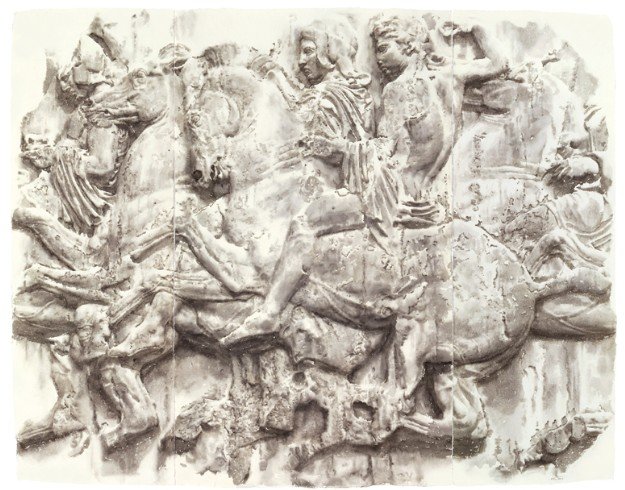The Parthenon Friezes
by Alexander Purves
Wendy Artin, Phrygian Cap, watercolor, 2011
✽ ✽ ✽
The Parthenon Friezes enjoy a room of their own in the British Museum. These fifth century marble reliefs are arranged along the walls in a linear sequence that surrounds the visitor. A skylight distributes even light over the horses, their riders and all the actors in the great procession as it makes its way around the room. Everywhere are stamping legs, creaking wheels, snorts and bellows - a maelstrom of activity straining to break out of the few inches of marble into which it has been compressed. But an uncanny quiet is present in the room. Action coexists with stillness, clamor with silence.
The power of this experience has moved generations of visitors. Wendy Artin has responded in her own way - as an artist. "For years I have been dreaming of painting them. I wanted to spend a long time staring at them, drawing them, getting lost in the cracks and relief, understanding the rhythmic movement of the heads, the bodies, the legs." She has come to know every swelling, every crevice. The watercolors are images of the sculptures, to be sure, but they pulse with a vitality of their own that is quite distinct from that of the originals. And this vitality comes from the act of painting.
Painting continues a process that began when the sculptor first captured the swirling mayhem of the actual procession as it thundered through real space in real time. He squeezed this activity into the shallow space between the face of the stone and the background plane. The watercolors further collapse these figures onto the surface of a piece of paper and add a dimension not present in the sculpture - that of ambiguity. The painter has the freedom to let an edge dissolve, to focus our attention on a neck, on a nostril, and leave other areas to be completed by our imaginations. We participate in the making of the image.
Our first response to these extraordinary paintings is to enjoy the cinematic rhythm of the legs, the draperies, the bodies - the power of the overall composition. However we are well repaid if we take the time to let our eyes graze slowly over the surface of the watercolor - to watch the artist pull the forms from the paper. Her brush has caressed every contour. Our eyes follow her hand as it guides the water over the rag paper leaving some spots dry, drenching others - always alive, always becoming. Working back from the white of the paper, applying water and pigment, deepening the darks, she is excavating shadows much as a sculptor carves into a block of marble to reveal form.
Two thousand years have taken their toll on the reliefs. An elbow vanishes; a knee appears from nowhere. But when we look at the sculptures we tend to overlook the missing fragments. Our eyes skip over the gaps, and we ignore the background plane. In the paintings every bit of marble - smooth or rough, intended or accidental - is examined and appreciated. In one piece, erosion has laid bare the texture of the stone allowing figures to appear to emerge from the fractured shadows - like apparitions. New stories arise.
In their original locations on the Parthenon, these reliefs would have been shielded from the brilliant Greek sun - tucked up in the shadows high above our heads and illuminated only by indirect light from below - sunlight reflected up off the marble floor. In the British Museum, however, a gentle London light drifts down, washing over the contours of the white Pentelic marble. Artin has been able to capture the effect of this light using water to soften the shadows and grade the darks. But as opposed to sculpture, the watercolors have a luminosity of their own, the reflection of light off the paper itself. No matter how dense the wash, this radiance is never lost.
Wendy Artin's Parthenon Friezes are meditations on works of art that have haunted her for many years. She is an artist of consummate skill, working in a medium over which she has complete control. However this skill never calls attention to itself. It is always used in service to the original sculptures. In these paintings she has been able to demonstrate the sensitivity and precision of her observation, but more significant - even miraculous - she has been able to convey the depth of her feeling - her wonder, her admiration and her love for these ancient marbles.
Alexander Purves
Yale School of Architecture
October 2011
Wendy Artin, Aprobate with Shield, watercolor, 2011

